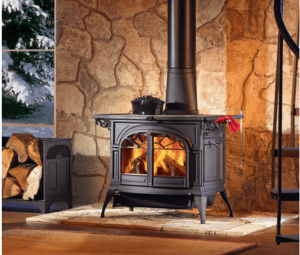Despite the EPA’s ban on the majority of wood burning stoves in America, 2.4 million American homes still use wood as their primary heating source according to the 2011 US Census Bureau’s survey statistics. This equals approximately 12% of homes in the US!
With October being fire safety prevention month, we feel like this is the perfect time to provide some valuable information on the proper usage and maintenance of wood burning stoves. Many more homes will use fireplaces as well during the upcoming winter months and this information will be beneficial to those homeowners too..
Choose the Correct Fuel – When choosing the type of wood to burn in your stove it is always advised to pick a hardwood like maple, ash, beech, oak or hickory. Hardwood, in comparison to softwood, burns much slower and will deliver much more heat. The wood you will eventually burn needs to be split and dried for a minimum of one year before burning. Certain climates with very low humidity like the deserts of Arizona may only take 6-8 months to dry out your wood, but a year is recommended. Hardwood that is well seasoned will show obvious cracks in the end grain once properly dried and sounds hollow when tapped against another piece of dried wood.
Create a Cleaning Schedule – At least once every year you should clean your stovepipe and chimney using a wire brush. You can also use controlled, high temperature fires occasionally to help burn off any build up in your wood stove. We suggest that you do not use the salt-based chemical cleaners to do the job, as they can create quite a mess unless you are very familiar with its application process. We highly recommend that you never use heavy objects tied to a rope such as bricks or chains to try and clean your chimney. This can cause significant damage. If you are not confident in your ability to perform this cleaning task you may want to pursue help from a professional chimney sweep company.
Watch for Creosote Buildup – Modern, air-tight stoves often burn fires at low temperatures to help preserve fuel. The temperature in the flue will commonly be between 100 to 200 degrees Fahrenheit. At these low temperatures the heat is not strong enough to carry all of the combustible gas particles completely out of the chimney. These particles then condense inside the walls of your stovepipe and chimney as creosote. Creosote can form in 3 different states.
- Creosote can form as a sticky liquid that will eventually run down into the fire and be burned off on its own.
- Creosote can form as a dry, flaky black deposit that you will be able to brush off with a stiff wire brush.
- The third form Creosote can take is a solid tar that becomes glazed over and can be next to impossible to remove. Chances are that you will need the help of a professional to have it thoroughly removed.
To help combat creosote buildup it is suggested that you install stovepipe thermometers to help you monitor low flue temperatures. You should also always keep your air inlets on your stove open. Restricting the air supply only helps creosote to form which can eventually lead to a chimney fire.
Protecting Your Home from the Outside – One of the best safety tips to protect your home is to install a mesh screen spark arrester on top of your chimney. This will help to prevent any rogue sparks from exiting your home and starting a fire outside. You will also want to make sure all tree branches near your chimney are removed or cut back to a safe distance. Keep your roof clear of any flammable debris like pine needles and leaves. The last outdoor safety tip is to keep your wood pile at least 30 feet from your home. You don’t want a cord of wood to catch fire near your home.
Protecting Your Home from the Inside – It goes without saying that you will need a minimum of one smoke detector or fire alarm in every room of your house. These alarms need to be tested at least once a month to ensure they are working properly. The installation of the wood stove itself needs to be vented properly with all vent pipes extending a minimum of three feet above the top of your home. Also be sure that all materials near or on your wood stove are fire resistant. Combustible personal items left too close to wood stoves are common culprits for household fires.
Using Your Wood Stove and Building a Fire – Always use the proper fuel to start a fire. Clean newspaper and small kindling work the best. Never use a flammable liquid to start a fire in your stove. Cardboard, trash and other debris should not be used to start or fuel your fire. For best results burn a hot, bright fire. You can adjust the intensity of the heat by adjusting the size of the fire. As the fire burns down to coals you will want to rake the coals into a mound toward the wood stove door and air inlet. Do not rake the coals flat. To increase your fire’s intensity it is suggested you add three pieces of wood at a time. Place them on or behind the mound of coals you have created. Try to avoid adding only one piece of wood at a time.
When it comes time to remove the ash be sure they have been allowed to cool completely before disposing of them. You will want to keep the ashes in a metal container with a tight cover. Always store these ashes at least 10 feet from any flammable structure and never empty them directly into a trash receptacle. It is also advisable to soak the ashes with water before finally disposing of them.

